THE CONQUEST OF BABYLON
Following on from his further conquests of lands surrounding the Tigris and Euphrates rivers, Cyrus fixed his attention onto Babylon. Cyrus found the demotion of the city’s patron deity Marduk and the forced labour of the citizens disgruntling. This too angered the Babylonian people, who turned against their king, having no reason to really oppose Cyrus as he had already built a reputation of not killing or enslaving those who yielded to him. The priests inside the city, displeased with king Nabonidus’s rule of the city, told of their wish for Cyrus to enter the city as their conqueror:
In the month of Arahshamnu, the third day, Cyrus entered Babylon, green twigs were spread in front of him - the state of Peace was imposed upon the city. Cyrus sent greetings to all Babylon.
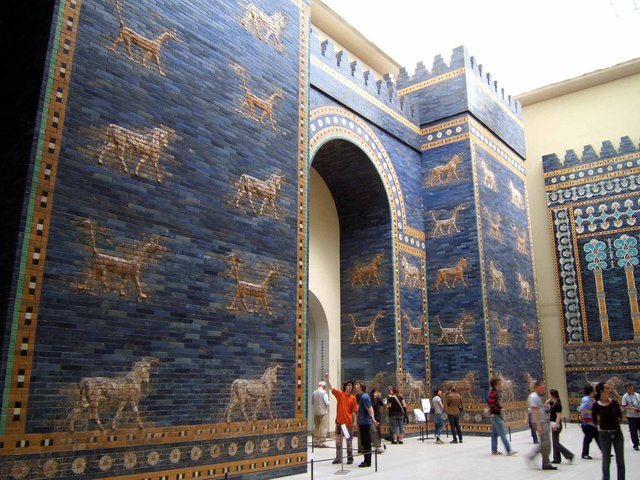
[ABOVE: Replica of the Ishtar Gate, the 8th gate to the inner city of Babylon, now in the Pergamon Museum, Berlin]
The River Gyndes
While Harpagus laid waste to western Asia, Cyrus marched on inland Asia, defeating every tribe he came across. Once most of the sub-continent was subdued, Cyrus attacked the Assyrians, marching to their most fortified settlement: Babylon. Upon reaching the River Gyndes, one of his sacred white horses charged across it in an attempt to cross it, but was submerged and swept by the river’s strong current. Angry with the river, Cyrus vowed to lower it to the point that even women would be able to cross it without even getting their knees wet; Dividing his army in half, he had his troops mark out 180 dead-straight channels on either bank, radiating out in all directions and positioned one on the other halves of his army on the opposite bank to start digging. While the workforce worked hard and well, it still took Cyrus all summer to complete the project.
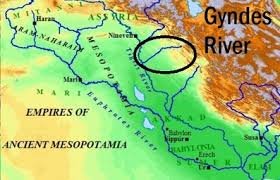
[ABOVE: The River Gyndes in Mesopotamia]
Initial Siege of Babylon
By the end of it, Cyrus had ‘punished’ the Gyndes River by dividing it into 360 channels. By the start of the second spring, he ordered his troops to continue their march towards Babylon, whose soldiers had been ordered outside of the city to await Cyrus’s forces. The Babylonians attacked as soon as Cyrus’s men approached the city, but lost the fight and withdrew behind Babylon’s high walls. This did not deter the Babylonians too much, as they had been keeping note of Cyrus’s rapid expansions across Asia, and so had stockpiled huge amounts of food and resources behind their walls, so much so that a defeat like that didn’t phase them. Cyrus didn’t know what to do from here.
Storming Babylon
Either he thought of this plan himself or someone else gave him the idea, but Cyrus ordered his troops to station themselves at a fair distance away from where the Euphrates (the river that ran through the city and essentially divided it into 2 parts) and posted some more soldiers behind the city where the river exits again. They were all ordered to wait until the river became more fordable and enter Babylon that way. Cyrus himself, meanwhile, along with some soldiers who were not fit for battle at the moment, withdrew to a nearby lake and set about diverting the flow of the river into Babylon and into the lake, making the river more fordable into the city. The Persians were on top of the Babylonians before they knew it to such a point that people living at the centre of the city were unaware of the ongoings by the city walls until they found out the hard way, since they were dancing in the city centre during a festive holiday. This is also a nod as to how vast the city of Babylon really was - today it’s considered an ancient Metropolis.
And so in 539 BC, the Babylonians opened the gates of their vast city to him. According to an inscription on Cyrus’s triumph through the city, he entered Babylon “in peace, amidst joy and jubilation”.
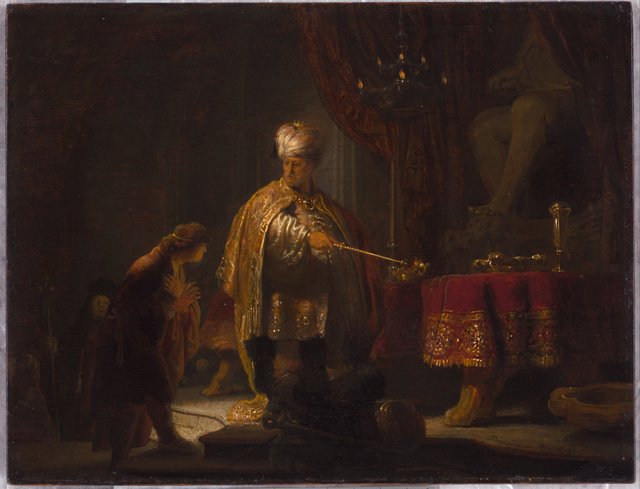
[ABOVE: "Cyrus the Great with Daniel', by Rembrandt van Rijn, 17th century]
Cyrus's Mercy
Cyrus’s benevolence lead him to appease the once powerful Medes by granting them high-end roles in the government. He also took on ornamenting and dressing himself in the style of the Elamites, an ancient Sumerian state east of the Tigris. Any images of a nation’s native gods were typically captured in battle and held behind the high walls of Babylon, but these were returned to their people under Cyrus. And in Babylon itself, he was known to publicly worship their patron God Marduk.
The Jewish Liberation
Perhaps what Cyrus is most famous for is his most benevolent act we know of: his freeing of the Jewish population held captive in Babylon. They were first held there in exile under the Babylonian king, Nebuchadnezzar II, and when the city was opened up to the Persians in 539, Cyrus returned the Jews to their promised lands. In scripture, the Jews praised Cyrus, describing him as a saviour unto who God gave them power over other nations, so that he could restore them back to their holy city of Jerusalem, allowing them to then rebuild their temple there that had previously been destroyed.
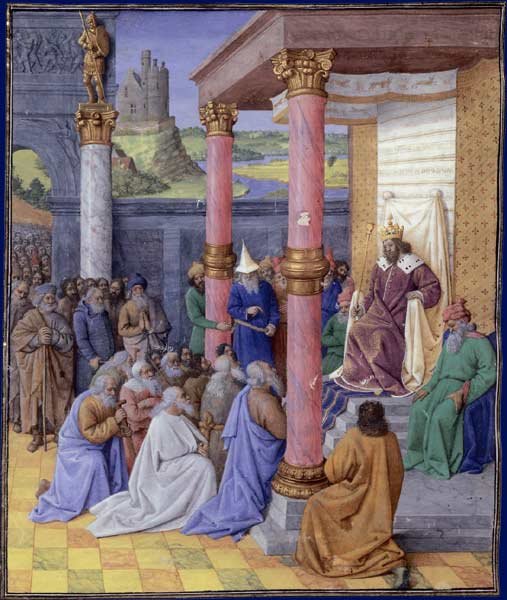
[ABOVE: Cyrus Liberating the Jews from Babylon, by Jean Fouquet, 15th century]
Jews in Persia
The Jewish peoples benefitted greatly from Achaemenid rule. Since 586 BC they had been held captive in Babylon, and were now freed by Cyrus. Ezra (a Jewish priest and scribe also called “Ezra the Scribe”) preserved Cyrus’s edict which was written in Aramaic, the language of the empire’s western half:
This is the word of Cyrus king of Persia: the Lord the god of heaven has given me all the kingdoms of the earth, and he himself has charged me to build him a house at Jerusalem in Judah. To every man of his people now among you I say, God be with him, and let him to up to Jerusalem in Judah, and rebuild the house of the Lord God of Israel, the God whose city is Jerusalem.
[Ezra, 1.2-4, NEB translation]
Under their leader Zerubbabel, the Jews returned to Jerusalem, where they established their temple-state under Nehemiah and Ezra: the Old Testament’s creation as the very narrative of the nation of the Jews in its relation to god, and the dominance of the priesthoods within Judaism, are all thanks to the restoration given to them by the Achaemenids. Therefore, to the Jews, Cyrus was:
the Lord’s Anointed
[Deutero-Isaiah 45]

[ABOVE: View of Jerusalem today, with the Dome of the Rock temple at the centre]
Judaism
Judaism today stands as the oldest surviving monotheist belief in the world, and it can trace its roots back to the 2nd millennia BC. Nothing stood as more important to Jewish peoples than their faith in God, which itself was founded on the belief of a covenant between God and the Jews themselves. Their holy book, the Torah, (the first 5 books of the Old Testament Bible) details the history of this relationship; God had promised the Canaanite lands to His chosen people - the Israelites, a Semitic tribal people whose origins were traced back to the patriarch Abraham. They soon after founded the city of Judah, setting up the city of Jerusalem as their capital around 1000 BC. In 587/6 BC, Nebuchadnezzar had the holy temple at Jerusalem destroyed, yet after Cyrus’s conquest of Babylon in 538 BC, the Jews were allowed to return to Jerusalem to rebuild their temple.

[ABOVE: The 9 Hannukah candles]
The Cyrus Cylinder
Today in the UN’s headquarters in New York lies a replica of the Cyrus Cylinder. It was written in Babylonian cuneiform near to the time of Cyrus’s conquest of Babylon, and was first discovered by British archaeologists in 1879. On it are inscribed the many details of Cyrus’s merciful acts, describing his willingness to allow conquered subjects to still practice their customs and traditions. This was an act not ever heard of by a king or conqueror before, especially during a time when kings pretty much “owned” their subjects.
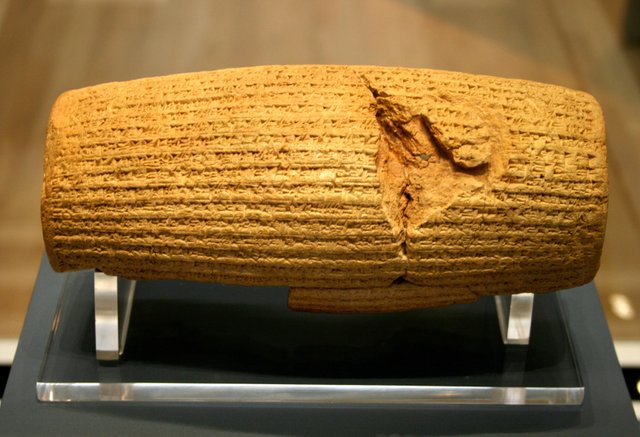
[ABOVE: A replica of the Cyrus Cylinder in the British Museum, London]
Cyrus’s Cylinder is generally considered as the first written bill of human rights in the world.
MARCH ON THE MASSAGETAE
Once Assyria was under the Persian domain, Cyrus set his sights on the Massagetae, a powerful warlike tribe living east of the Caspian Sea across the river Araxes. They resembled the Scythians: nomadic peoples living and fighting mainly on horseback, and fighting mainly with a bow and spear. Their weapons were made of bronze and their kit and clothing decorated with gold. The main reasons Cyrus wanted to march on these people were twofold: the nature of his birth and the fortune that seemed to follow him in war; any race that found itself fighting Cyrus’s army never escaped.
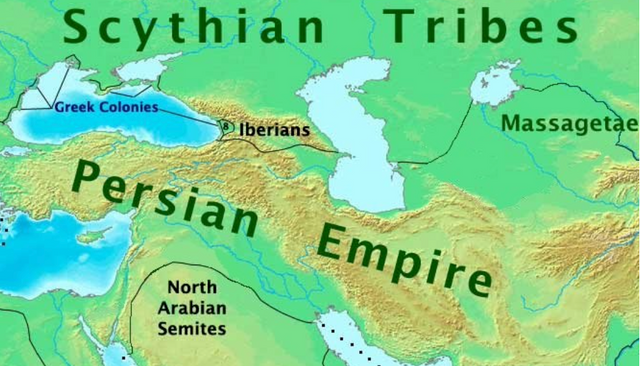
[ABOVE: The lands of the Scythian Massagetae tribes, Central Asia]
Tomyris
In Cyrus’s time, a woman, Tomyris, ruled the Massagetae, since her husband had died. Cyrus sent envoys to her, asking for her to be his wife, but realising that he was after the lands of the Massagetae and not the ruler, she refused the offer. Receiving this response, Cyrus wasted no time in marching up to her lands, bridging the rivers to get there and waging war against the Massagetae. Tomyris sent a message to Cyrus, asking him to end his attacks:
King of Persia, abandon your zeal for this enterprise. You cannot know if in the end it will come out right for you. Stop and rule your own people, and put up with the sight of me ruling mine. But no: you are hardly going to take this advice, since peace is the last thing you desire. If you really are committed to a trial of strength with the Massagetae, you need not bother with all the hard work of bridging the river; we will pull back three days’ journey away from the river and then you can cross over into our land. Or if you would rather meet us in your land, you withdraw the same distance.
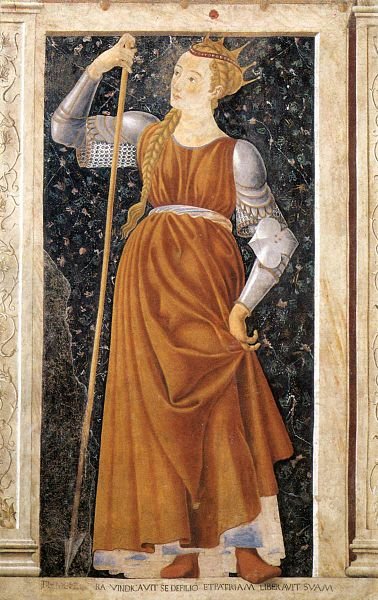
[ABOVE: Painting of Tomyris, imagined by Andrea del Castagno, 15th century]
Croesus's Advice
Hearing this message, Cyrus called all his leading officers and advisors, including Croesus, to a meeting. Together they agreed that they should meet Tomyris’s forces on their own ground. However, Croesus disagreed. He told him that since he believed Zeus had handed him over to Cyrus before, he saw it as his duty to avert the Persian king from any catastrophe. His main concern lay with the idea that if Cyrus lost his army against the Massagetae, he’d lose his entire empire, as the Massagetae wouldn’t be keen on simply marching back home after a victory like that. Moreover, a victory for Cyrus on his side of the river wouldn’t gain him as much in return as a victory on the Massagetae side of the river would have, since a Persian victory on the Massagetae side of the river would follow with the Persian army chasing them down without a further river crossing. It would also have been demeaning in his eyes for Cyrus to march away from a woman. Croesus decreed therefore that Cyrus should cross the river and advance forward as far as the Massagetae withdrew. Croesus’s plan, since the Massagetae were a nomadic tribe and knew very little in the ways of luxury, was to have lots of animals slaughtered for a welcoming feast, along with undiluted wine, then leave the least valuable detachments of the army behind and withdraw the rest back to the river. Once the Massagetae saw all this food and drink, they would go for it, allowing the main Persian forces to achieve victory elsewhere. Cyrus went with this plan instead.
Crossing the River Araxes
Telling Tomyris to pull her troops back, Cyrus crossed the river. Tomyris pulled back in response, as she said she would do. Wanting to keep Croesus safe, Cyrus handed him to his son Cambyses, who he wanted to leave the empire to should the Massagetae campaign not go well. He told Cambyses to treat Croesus with the upmost respect, and then marched his army across the river to face Tomyris.
Initial Success
The plan played out well at first: the army crossed the river and the weaker portion of it marched forward and faced the Massagetae forces. While they put up a good fight, they were ultimately defeated and slaughtered. The feast that was laid out before was consumed by the Massagetae. Once they fell asleep, full on plenty of food and alcohol, the rest of the Persian forces marched on them and killed them. This portion of the Massagetae force was either butchered or taken prisoner. Among the prisoners was Tomyris’s son, Spargapises, commander of the army. Hearing of this sneaky victory, Tomyris sent envoys to Cyrus, decreeing that his victory had been a cheat and that she wanted the remnants of her army, and her son, returned to her, under the threat of attacking. Once Spargapises sobered up from the wine, he realised what had happened to him and his forces, and begged to be released. Cyrus agreed and released him, but as soon as he was free, Spargapises killed himself.
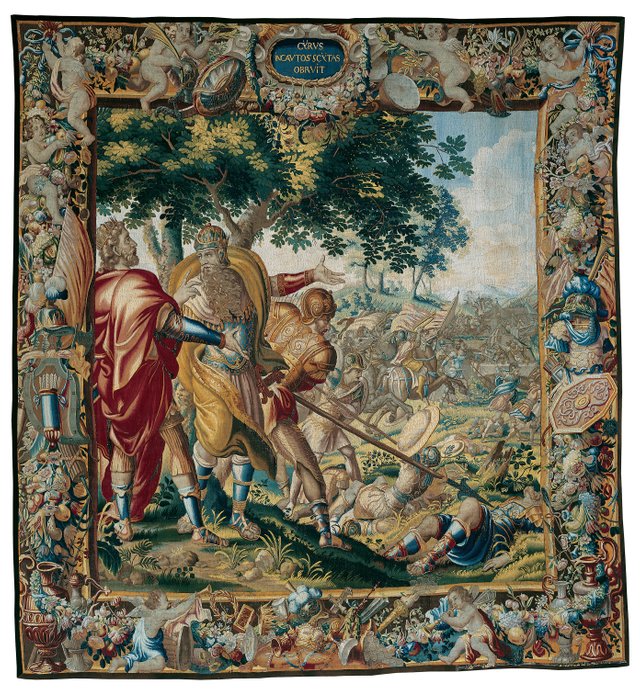
[ABOVE: "Cyrus Defeats Spargapises", woven by Albert Auwercx, c.1670]
Cyrus Falls
Since Cyrus refused her advice, Tomyris marched the rest of her forces towards the Persians. The battle began with an exchange of arrow fire from either side, but when arrows were depleted, they fought each other with spears and daggers. It was here that the Massagetae eventually came to gain the upper hand, and in the vicious fighting, Cyrus was killed. His body was taken to Tomyris, and she had his head cut off and stuck in a wineskin with human blood, decreeing to the head that she was finally quenching his thirst for blood.
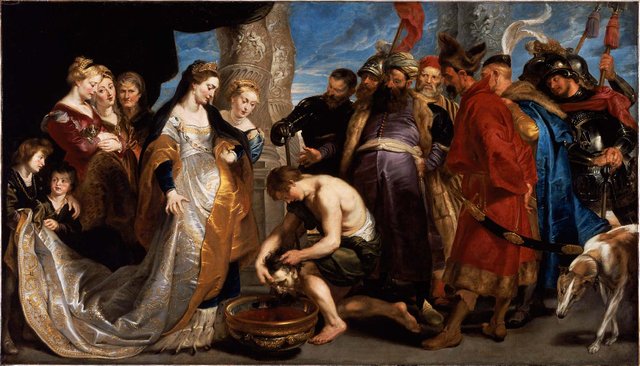
[ABOVE: "Tomyris Plunges the Head of the Dead Cyrus Into a Vessel of Blood", by Peter Paul Rubens, 1622/3]
This is the account of Cyrus’s death that Herodotus gives us. Other ancient historians say that he died peacefully in his sleep. He had reigned as king of the Achaemenid Persian Empire for 29 years.
CYRUS'S LEGACY
The Greeks held Cyrus in very high esteem, despite the wars fought between them and Cyrus’s successors years later. Even 150 years on, the Greek writer Xenophon highly memorialised the conqueror-slash-liberator in his work the “Cyropaedia”:
He honoured his subjects and cared for them as if they were his own children, and they, on their part, revered Cyrus as a father.
Even in modern history, this all inspired the 3rd US President, Thomas Jefferson, to keep 2 separate copies of Cyropaedia with him.
I am Kyros, who gave the Persians an empire, and was king of Asia.
[Epitaph on Cyrus’s stepped tomb]
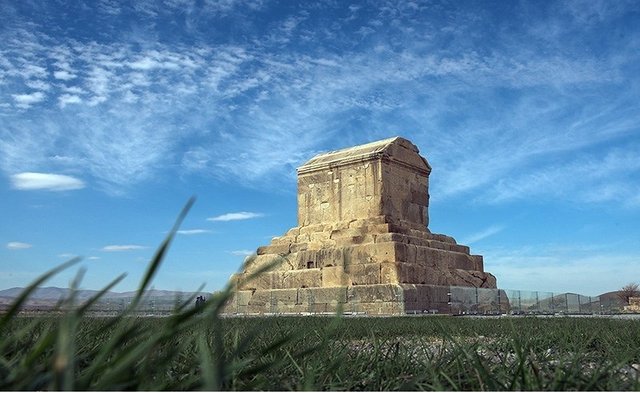
[ABOVE: Cyrus's Tomb in the Achaemenid city of Pasargadae]
--
SOURCES:
• Herodotus's "The Histories"
• Oswyn Murray's "Early Greece"
• Robin Osborne's "Greece in the Making, 1200 - 479 BC"
• Philip Parker's "World History"
• National Geographic's "The Most Influential Figures of Ancient History"
• Nic Field's "Thermopylae 480 BC"
All images used are licence-free
--
This is the third part in many blogs on the Achaemenid Empire.
Check out my previous blog on Cyrus the Great and his earlier conquests:
https://steemit.com/hive-133974/@oo7harv/cyrus-the-great-conquests-of-media-and-lydia
I'll be diving next into the heirs of Cyrus, Cambyses and Darius, and their successes in bringing the Persian Empire to its territorial height.
Any and all feedback is welcome.